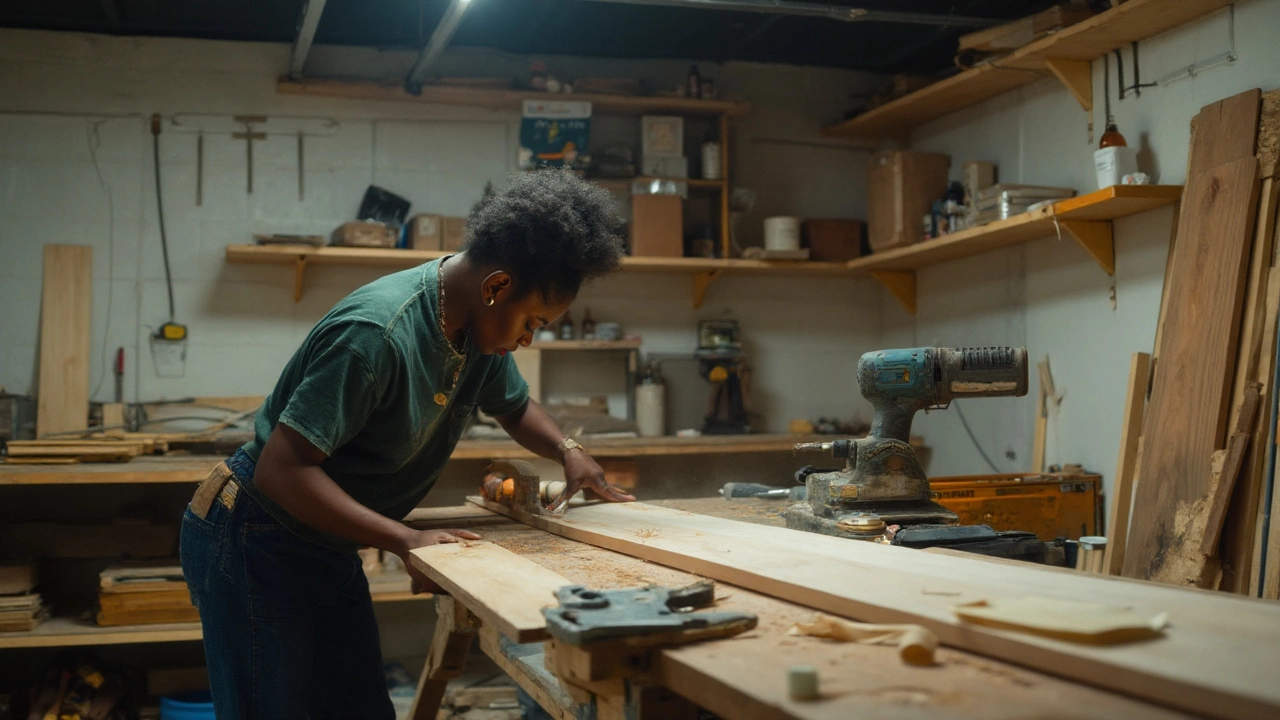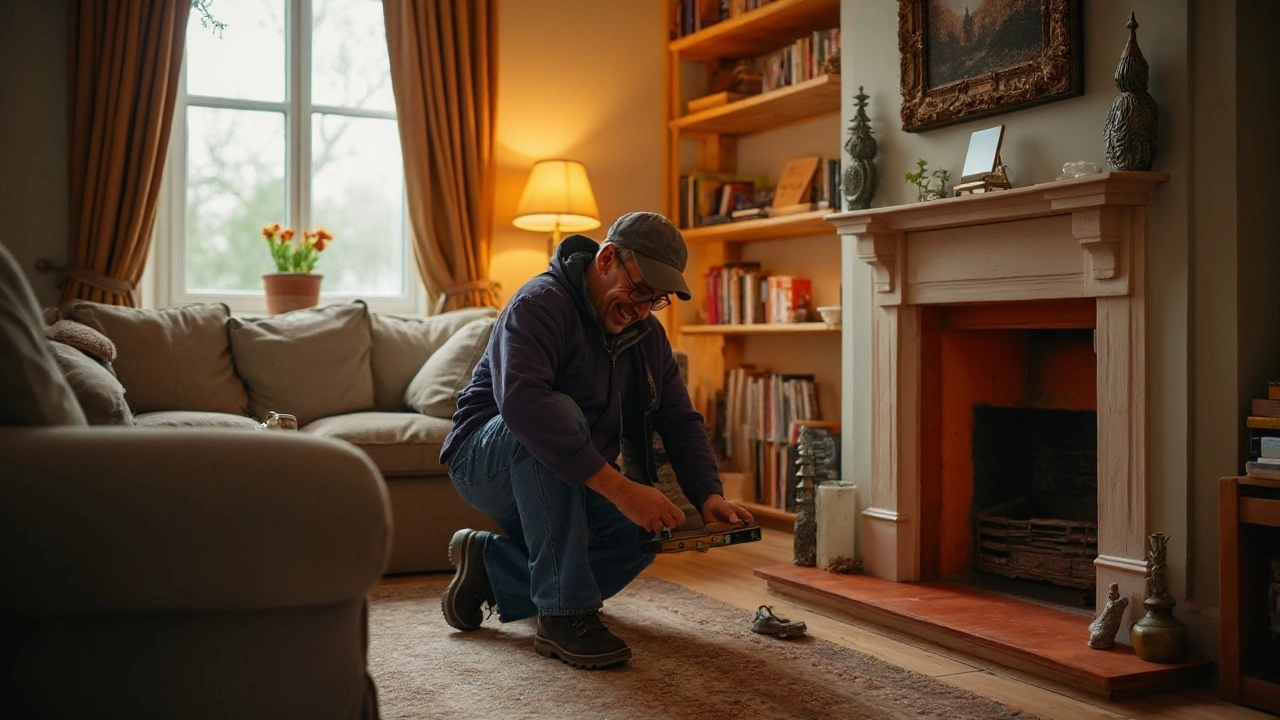TL;DR: When making shelves is cheaper than buying
You clicked to save money, not collect receipts. Here’s the short answer.
- Buy if you need one or two simple shelves in standard sizes. In the UK right now, budget ready-made floating shelves start around £12-£25, decent brackets £2-£10 each. After tools and finish, DIY rarely beats that for just one shelf.
- DIY wins when you’re doing multiple shelves, non-standard sizes (alcoves, awkward corners), or heavy loads (vinyl, books, pantry). Your materials cost per shelf drops fast across 3-6 shelves.
- Expect DIY materials for a 80-100 cm shelf (pine/MDF + brackets + fixings + finish) to land around £18-£45. A good ready-made alternative is usually £20-£50. The tie-breakers are tools and your time.
- If you already own a drill, saw, and sander, DIY often saves 20-50% for built-ins or runs of 3+ shelves. If you don’t, the tool spend can wipe out savings on small jobs.
- Hidden costs people forget: delivery fees for full-size boards, wasted offcuts, returns, wall anchors for your wall type, and paint/varnish you’ll barely dent but still pay for.
Prices reflect UK high-street and online listings checked against IKEA, B&Q, Wickes, Screwfix, and Toolstation catalogues in late summer 2025.
UK price reality check (2025): materials, tools, and the maths
I live in Bristol in a skinny terrace with alcoves that don’t fit anything standard. I’ve built shelves for books, records, and a frankly embarrassing number of cookbooks. Here’s what the receipts look like this year.
Typical material costs (per shelf or per pack):
- MDF (18 mm): £30-£40 per 2440 × 1220 mm sheet (enough for 5-8 shelves depending on depth). MDF paints smooth but can sag if deep and heavily loaded.
- Softwood/pine board (planed): £8-£18 per 2.4 m length, common widths 144-218 mm. Light, decent strength, easy to work.
- Plywood (18 mm): £40-£65 for basic spruce; £70-£110 for birch ply. Stronger/stiffer than MDF of the same thickness. Edges look nice with a clear finish.
- Edge banding (if you want a clean front on MDF/ply): £5-£12 per roll.
- Brackets (visible L or heavy-duty): £2-£10 each. You usually need 2 per shelf, 3 for wide/heavy runs.
- Floating/hidden brackets (stud/solid wall): £8-£20 each. Check load rating and wall type.
- Screws and wall plugs: £5-£10 a box. Get masonry anchors for brick/block and appropriate anchors for plasterboard.
- Finish: primer/paint or varnish/oil: £12-£25 per tin (you’ll use a fraction now, the rest later).
Tools (one-off if you don’t own them):
- Drill/driver: £40-£120. A masonry bit set for brick walls adds ~£10-£15.
- Handsaw or circular saw: £15-£80. A track saw or having the shop cut your sheet can keep edges straight.
- Sander + paper: £25-£60, or hand-sand with a block for small jobs (£5-£10 for paper).
- Stud finder (for plasterboard walls): £12-£25. Optional but sanity-saving.
- Spirit level: £8-£20. A long one is worth it for runs of shelves.
Note on board cutting: Most DIY stores will cut sheets for a small fee or free for the first few cuts. This can save you buying a saw and makes car boot Tetris less dramatic.
Rule-of-thumb costs (per shelf, excluding tools):
- Budget DIY 80-100 cm shelf, painted MDF + basic brackets: £18-£30.
- Mid-range DIY softwood/ply + decent brackets: £25-£45.
- Floating DIY shelf with hidden brackets: £30-£60, higher for deep or long spans.
Rule-of-thumb for ready-made:
- Budget floating shelf (70-120 cm): £12-£25.
- Mid-range solid wood/bracketed shelf (80-120 cm): £25-£60.
- Premium/solid oak or bespoke sizes: £60-£150+.
The simple maths:
DIY total = Materials + Hardware + Finish + Delivery/Waste + Your tool cost share + Your time value.
To estimate your tool cost share, spread the tool price over expected future projects. Example: If a £60 drill will serve 10 jobs, count £6 per job. Same idea if you’ll build six shelves today: spread consumables across all six.
Your time matters. If you value your time at £20/hour and a shelf takes you 2 hours, add £40. If you enjoy it and call that cost £0, fine-but be honest about evenings disappearing into sanding.

Step-by-step: Decide make vs buy for your space
If you want a clean yes/no, use this quick path. Grab a tape, a notebook, and a cup of tea.
Define the job. What are you storing and how long/deep must the shelf be? Books and vinyl are heavy; 18-22 mm thick boards and sturdy brackets are safer. Pantry jars are lighter; 12-18 mm can work. Note your wall type (brick, block, plasterboard). If you don’t know, tap it: hollow echo suggests plasterboard; hard thud suggests masonry.
Check standard sizes. Search for shelves in your length/depth range at IKEA, B&Q, Argos, John Lewis, and Amazon UK. If 2-3 options fit and the look/finish is fine, price them. If nothing fits, DIY starts making sense.
Estimate DIY materials. Choose a board material (MDF if painting, ply or pine if clear-coating). Price the board, add brackets and anchors, and include a slice of finish. If you need three shelves, multiply. Add a small waste/delivery buffer (10-15%).
Add tools (if needed). If you lack a drill or saw, either add the cost share (if you’ll use them again) or price a one-day hire. Hiring a cordless drill locally is often £15-£25/day; check your area. Some stores cut boards so you can skip a saw.
Put a number on your time. Beginners: expect 2-4 hours per shelf including measuring, cutting, sanding, finishing, and install. Faster if the store cuts for you, slower for floating shelves in plasterboard.
Compare outcomes, not just cost. Will the bought shelf meet your load and length? Will brackets land on studs? Does the finish match your room? If the ready-made solution compromises size, strength, or look, DIY’s value increases even if cash costs tie.
Heuristic you can trust: For one basic shelf in a standard size, buy. For three or more shelves, custom lengths, or alcoves, build. For a single heavy-duty shelf in plasterboard with no studs where you want them, either build with proper anchors and a cleat or buy purpose-made heavy-duty hardware-don’t cheap out.
Real-world examples, scenarios, and a quick comparison
Numbers beat opinions. Here are UK-flavoured scenarios I see all the time in Bristol terraces and flats.
1) One 100 cm floating shelf for light decor
- Buy: £15-£30 for budget floating shelf, fixings included. Install time: 20-45 minutes. Will hold small decor/frames. Weight ratings vary; plasterboard needs care.
- DIY: MDF offcut or pine board £8-£12, two hidden brackets £20-£30, primers/paint £5 share, plugs/screws £2 share. Cash: £35-£55. Time: 2-3 hours including paint. Verdict: Buying is cheaper and faster unless you need a precise length/depth.
2) Three alcove shelves for paperbacks (each 90-100 cm)
- Buy: Three mid-range bracketed shelves £25-£40 each = £75-£120. Brackets often included; you may still need better wall anchors. Install: 2-3 hours.
- DIY: One MDF sheet £35, cut into three pieces at store; paint share £6; heavy-duty brackets 6 × £6 = £36; plugs/screws share £4. Cash: ~£81. If you already own tools, DIY likely ties or beats the mid-range buy, and you control exact length to hit each alcove wall, which looks built-in. With pine/ply, total may be £90-£120 but with a nicer finish.
3) Garage shelving for bulky storage
- Buy: Flat-pack boltless racking units (5 tiers) run £40-£90 per bay. Two bays: £80-£180. Strong, fast, adjustable.
- DIY: Timber, screws, and OSB/ply shelves can match or exceed strength. But by the time you buy timber, ply/OSB, and fixings, DIY often lands in the £100-£160 range per two-bay equivalent, plus an afternoon of cutting. Verdict: Buying racking is usually cheaper and stronger per pound unless your garage dimensions are awkward.
4) Built-in look with a face frame in a living room alcove
- Buy: True custom shelves from a joiner easily hit £300-£800+ depending on finish and span. Flat-pack units won’t fit perfectly.
- DIY: MDF/ply + softwood face frames: £70-£150 in materials for 3-4 shelves, plus filler, caulk, and paint. Time: a weekend. This is where DIY shines if you’re patient with finishing.
Why ranges vary: wood species, depth (200 mm vs 300 mm changes stiffness), bracket type, and especially wall type. Brick with a good masonry anchor will take more than plasterboard with a hollow wall anchor placed off-stud.
Here’s a compact comparison that reflects the patterns I see:
| Use case | Buy cost (typ.) | DIY cost (typ.) | Winner (cash) | Notes |
|---|---|---|---|---|
| 1 budget floating shelf (100 cm) | £15-£30 | £35-£55 | Buy | DIY only if you need exact size/finish |
| 3 alcove shelves (book weight) | £75-£120 | £80-£120 | Tie | DIY wins on fit and look |
| 2 garage racking bays | £80-£180 | £100-£160 | Buy | Racking is fast and strong |
| Built-in living room alcove (face-framed) | £300-£800+ | £70-£150 | DIY | Time-heavy, but cheap in materials |
When I did our living room alcove, I sized the shelves to the skirting quirks and let Nathaniel hold the level while I drove the screws. The fit makes the room feel finished in a way a shop shelf never could.

Checklists, Mini‑FAQ, and your next steps
Here’s the stuff that actually saves money and stress.
Buy checklist
- Measure length, depth, and the clear space for brackets. Write it down-don’t trust your memory in the aisle.
- Check load rating and wall type compatibility. Many “floating” kits assume solid walls.
- Scan finish quality: pre-drilled holes aligned? Veneer edges tidy? Hardware included?
- Factor in anchors. If the box just includes generic plugs, you may need plasterboard anchors or masonry-specific plugs.
- Delivery or click-and-collect? Long shelves don’t love buses or small boots.
Build checklist
- Pick materials for the load: 18-22 mm MDF for painted light/medium loads; 18 mm ply or solid wood for books/vinyl.
- Span vs sag: Over 80-100 cm, add a center bracket or a front stiffener (lipping) to prevent bowing, especially with MDF.
- Brackets to structure: Find studs in plasterboard or use high-quality hollow wall anchors. In masonry, drill the proper diameter and depth for your plugs.
- Seal edges: MDF drinks moisture. Prime edges well before paint. Ply edges can look great with clear coat; sand to 180-220 grit.
- Pre-finish before install. Painting on the wall is misery. Do two coats on sawhorses, then touch up after.
Quick decision tree
- Need 1-2 shelves, standard size, light load? → Buy.
- Need 3+ shelves, custom lengths, or built-in look? → Build.
- Heavy load (books/vinyl), plasterboard wall, no studs where you want them? → Build with proper anchors/cleat or buy heavy-duty system rails.
- No tools and no plans to DIY again? → Buy or borrow tools. Hiring for one shelf rarely pays.
- Renter who can’t drill? → Buy freestanding units, tension poles, or no-drill shelves with floor-to-ceiling compression (check lease).
Mini‑FAQ
- What’s the cheapest shelf I can make that doesn’t sag? A 18 mm pine or spruce shelf up to ~80 cm with two decent brackets is the sweet spot. Keep depth near 200-250 mm for books. Add a third bracket for 100-120 cm spans.
- Are floating shelves weaker? They can be if the hidden brackets are low-quality or installed in plasterboard off-stud. In brick/block, properly set rods are strong. Always check bracket load ratings and wall type.
- Is MDF bad in kitchens and bathrooms? It’s fine if you seal it well, especially edges, and avoid direct water. Plywood or solid wood is more forgiving in humidity.
- How much should I budget for finishing? If you already have paint/varnish, great. If not, allow £12-£25. You’ll reuse it on future touch-ups.
- What about sustainability? DIY lets you cut to fit and reduce returns. Plywood often lasts longer than MDF under load. Buying once, buying right beats replacing bowed shelves in a year.
Next steps: pick your lane
- Fast and done: Buy a ready-made shelf in your size. Add the right anchors for your wall. You’ll be sipping tea under a new shelf tonight.
- Value but custom: Have the store cut MDF/ply to your exact sizes. Sand, prime, paint, then hang with solid brackets. This gives a built-in look without a joiner’s bill.
- Hobby mode: Build a face-framed alcove set. Budget a weekend, measure twice, scribe to the walls, and enjoy a bespoke finish for the cost of a nice dinner out.
Troubleshooting
- Shelf sags in the middle: Add a center bracket, flip and add a front lipping strip (12-20 mm), or switch to plywood/solid wood. For deep shelves, go thicker or shorten the span.
- Screws pull out of the wall: You likely used the wrong anchors. For plasterboard: use toggle/butterfly anchors or snap toggles for heavy loads, or move brackets to studs. For masonry: use correct-diameter masonry plugs and drill to full depth.
- Floating shelf wobbles: Pilot holes may be oversized or the rods too short for the depth. Re-drill accurately, use epoxy in the holes (carefully), or switch to a cleat/bracket system.
- Finish looks rough: Sand to 180-220 grit, vacuum dust, use primer (especially MDF edges), then lay thin coats. Don’t rush drying times; they’re on the tin for a reason.
- Bracket spacing looks off: Use a story stick (a marked scrap) to transfer measurements. Level the first bracket, then mark the second with the stick-not the tape.
Credibility check
Price ranges here line up with current catalogue pricing and in-store checks from IKEA UK, B&Q, Wickes, Screwfix, and Toolstation (Aug-Sep 2025), plus the usual weekend pilgrimages many of us make. Stock and promos swing costs, but the ratios don’t change much.
If you skimmed to the end, here’s your compass: single standard shelf-buy. Multiple shelves or custom spans-build. Heavy loads-prioritise structure and anchors. And if you’re still torn, cost out both paths in five minutes: jot the parts list, assign prices from one retailer, include a small tool share, and compare to a mid-range ready-made in your size. Nine times out of ten, the choice becomes obvious. That little exercise has saved me more money-and arguments-than any fancy calculator.
Oh, and one SEO thing you might actually care about: if you search DIY shelves cost at 2 a.m., save the cart until morning. Fresh eyes add up better than midnight optimism.

